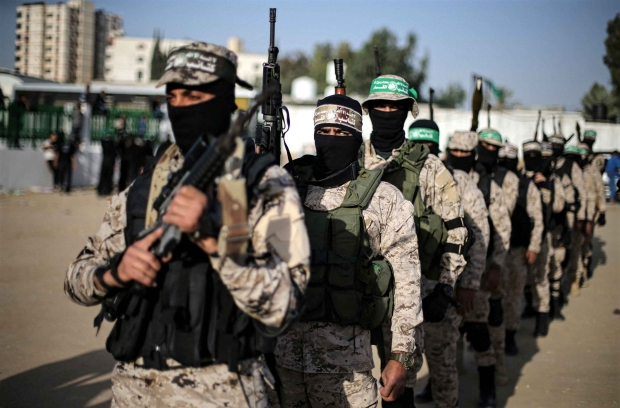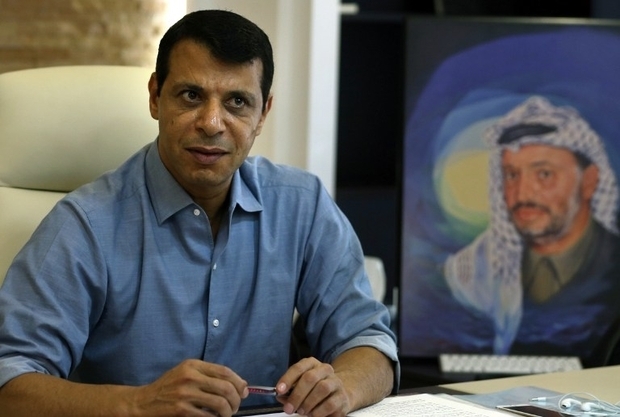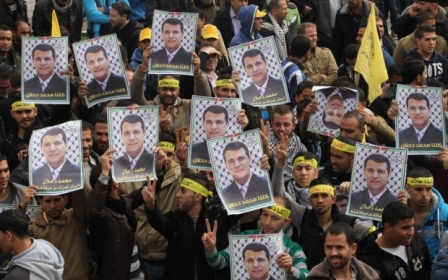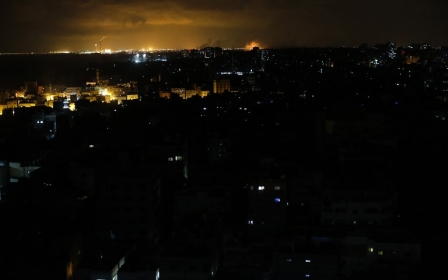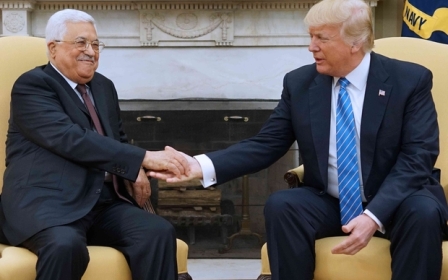Why Hamas was not on the Saudi list of demands for Qatar

There was one notable omission from the list of 13 demands that Saudi gave Qatar 10 days to fulfil.
The movement in question is undoubtedly sheltered by Qatar. It grew out of the Muslim Brotherhood and seeks the destruction of the state of Israel. Both the Saudi Foreign Minister Adel al-Jubeir and US Ambassador Nikki Haley have called on the UN Security Council to list it as a terrorist organisation.
And yet Hamas appears to have dropped off the list presented to Qatar on Friday.
A few days before this list emerged, another curious event took place in Cairo. Mohammed Dahlan, the arch rival of the Palestinian president Mahmoud Abbas, and a man bankrolled and sheltered by the Emiratis, was in town to meet two Hamas men, one an elected official.
Al-Resalah, a Hamas newspaper in Gaza, confirmed the meeting took place but denied that Dahlan himself was present.
Dahlan presented Sinwar with a comprehensive plan, the guts of which was this: “You allow me back into Gaza, and I will ease the blockade on the Egyptian border.”
A pro-regime Egyptian newspaper Al Fajer, went further: Dahlan, it reported, will lead the government in Gaza, control the crossing with Egypt and Israel and the finance, while Hamas will keep the interior ministry and its employees will be treated as part of the administration. This may not materialise, but it at least shows the direction of travel.
As the siege imposed on the Egyptian border has been even more brutal than the one imposed by Israel, the offer was tempting. So tempting that Sinwar apparently shook hands on it. Within days, fuel trucks rolled through the crossing point at Rafah.
The only problem with this new arrangement was that the rest of Hamas knew nothing about it.
Four years, one meeting
Sinwar is the leader of Hamas in Gaza. Of the three sections of Hamas - Gaza, the West Bank and the diaspora - Gaza is the most important because it is a de facto state, but it is only one of three.
Above all of them lies the Shura Council which elects the head of the political executive. The current head of the executive is Ismail Haniyeh, who replaced Khaled Meshaal in Doha last month. For the first time in the history of the movement, the head of the political executive lives in Gaza and therefore his movements are restricted by the siege.
Haniyeh has told associates he knew nothing about Sinwar’s meeting with Dahlan. Still less did he sanction its alleged decision.
It took four years of internal discussion to change its charter. It apparently took one meeting for Sinwar to reverse a policy which has been in existence for 11 years
But Sinwar’s first action as head of Hamas in Gaza has created an unprecedented crisis for the movement as a whole. Over decades, it has made cautious, deliberate steps and only after lengthy periods of consultation with all parts of the movement.
It took four years of internal discussion to change its charter. It apparently took one meeting for Sinwar to reverse a policy which has been in existence for 11 years, since the siege started.
An informed source told me: “This is very dangerous and unprecedented for the movement. This is a clear attempt to split Hamas, which ever since 1992, when the brains of the movement moved outside Gaza, made strategic decisions only after extensive collective consultation.
“The UAE want to squeeze Turkey and Qatar out of Gaza. Dahlan and the UAE want to deal a blow to the Qatar-Turkish axis by splitting Hamas.”
Courting Trump
Dahlan’s offer to alleviate the siege was both toxic and tempting.
Tony Blair made a similar offer to Khaled Meshaal in a series of talks which I first revealed. Blair offered to lift the siege in return for a hudna (a truce). The talks fell through because neither Israel nor Egypt were behind them. But Meshaal was wary of trading the right, as Hamas sees it, to resist occupation for unlimited supplies of pasta and chocolate.
When a supporter raised a photograph of Abbas in the grounds of Al Aqsa on the day of Eid, a crowd attacked and destroyed the image chanting “traitor, traitor”.
It could be that Abbas feels he has no other choice. Abbas and his main Fatah rival, Dahlan, are in a deadly competition for Trump’s affection.
Abbas and his main Fatah rival, Dahlan, are in a deadly competition for Trump’s affection
Dahlan has already tried once to return to Palestine by attempting to stage a reconciliation with Abbas. The Palestinian president rejected this and cut Dahlan’s supporters out of the Fatah central committee. Now Dahlan is trying a new route in through Gaza and Hamas.
Trump’s statement before more than 50 Arab and Muslim leaders in Riyadh that Hamas was a terrorist organisation, the declared hostility of the Arab states, and now Dahlan’s latest attempt to buy an entry visa from Hamas, all set the context for the meeting with Sinwar.
The Gaza link
For the moment, both Abbas and Dahlan are serving the Saudi and Emirati interest in wanting to see Hamas cut down to size and to see Qatar’s influence diminish over Gaza. Qatar is the largest international donor to the Strip, pledging $1.3bn for its reconstruction. It pays money directly to workers on construction sites. With an unemployment rate of over 40 percent, that money and that work is the only game in town.
What was the Saudi response to a gesture to soften a negotiating position? To declare Hamas a terrorist organisation
The blockade of Qatar is intimately connected to the siege of Gaza.
Until the Cairo meeting, Hamas as a movement played both sides of Fatah off each other.
On Abbas’s request, Hamas allowed hundreds of Fatah delegates to travel from Gaza to the West Bank, so that they could vote for Abbas’s candidates for the Fatah central committee. This was an operation intended to keep Dahlan and his supporters out of power and out of the West Bank.
By the same token, Hamas sent delegates to a series of meetings in Cairo, which brought them closer to Dahlan. Dahlan and Egypt saw this strategy working.
For Hamas, the lessons of both the Gulf power struggle and the Fatah struggle are bitter.
Hamas had, in fact, just replaced its original charter with a document that recognised Israel's 1967 borders. The movement did this to make it easier for all Palestinian factions to adopt a common position, but also to help the Arab states who were trying to resuscitate the Arab Peace Initiative. What was the Saudi response to a gesture to soften a negotiating position? To declare Hamas a terrorist organisation.
This is in keeping with Fatah’s history. One concession after another was demanded of the party, and they got nothing in return. In the process, they alienated their support which went broadly to Hamas. If Hamas starts to haemorrhage support in the way Fatah did, these people would not go back the way they came. They would swell the ranks of Takfiri groups like the Islamic State group.
Sinwar emerged from more than 20 years of Israeli prison with the reputation of being a militant hardliner. He was released as part of the prisoner exchange with the captured Israeli soldier Gilad Shalit.
The attraction of negotiating with him was the same the British felt in opening talks with Michael Collins, the IRA leader and revolutionary hero of the War of Independence. However, Collins became the man who gave the orders to open fire on the four courts in Dublin with artillery shells against his own former men, who formed the anti-Treaty IRA. That kicked off the Irish civil war.
Does Sinwar want to follow either in Collins’ footsteps or indeed those of Mahmoud Abbas?
- David Hearst is editor-in-chief of Middle East Eye. He was chief foreign leader writer of The Guardian, former Associate Foreign Editor, European Editor, Moscow Bureau Chief, European Correspondent, and Ireland Correspondent. He joined The Guardian from The Scotsman, where he was education correspondent.
The views expressed in this article belong to the author and do not necessarily reflect the editorial policy of Middle East Eye.
Photo: Yahya Sinwar (C), the new leader of Hamas in the Gaza Strip, arrives for the opening of a new mosque in Rafah town in the southern Gaza Strip on 24 February 2017. (AFP)
This article is available in French on Middle East Eye French edition.
Middle East Eye propose une couverture et une analyse indépendantes et incomparables du Moyen-Orient, de l’Afrique du Nord et d’autres régions du monde. Pour en savoir plus sur la reprise de ce contenu et les frais qui s’appliquent, veuillez remplir ce formulaire [en anglais]. Pour en savoir plus sur MEE, cliquez ici [en anglais].



